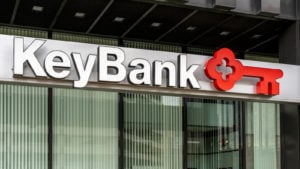The sector might be set for a resurgence after a tough year for bank stocks that included multiple meltdowns, like Silicon Valley Bank. Banking indices climbed in 2023’s latter half and seem to maintain that momentum today. Of course, most of that bullish sentiment is on the heels of assumed interest rate cuts – which, if they don’t bear out as expected, could prove devastating to the same stocks surging today.
In either case, a handful of bank stocks should be at the top of your Sell list, whether or not our collective low-rate dreams come to fruition. These stocks tend to struggle with lending, as in the case of regional banks unable to make money or (conversely) lending too much considering the current credit risk customers present.
Comerica (CMA)

Comerica (NYSE:CMA) had a tough 2023, but it isn’t out of the water yet. The bank stock’s market cap sits at just below $7.4 billion despite its current S&P 500 membership. Stocks must have a market cap of $12.7 billion or more for index inclusion. While that doesn’t affect current members directly, companies like Palantir (NYSE:PLTR) are banging down the door to index inclusion, creating risk for smaller companies like Comerica as they hang on by a thread. The company may be following in Lincoln National’s (NYSE:LNC) footsteps, which likewise got removed from the large-cap index in 2023 on the heels of a falling market cap.
The growing trend of self-guided fixed-income investing is challenging traditional banks to retain their customers. This shift is evident at Comerica, where net deposits keep dropping as consumers grapple with rising debt and the allure of managing their own income investments. Comerica also faces higher overall costs due to rising interest rates, undermining a fundamental aspect of the regional bank’s business model: loans and lending.
With interest rates climbing, consumers are increasingly hesitant to take on loans for personal, auto, and mortgage purposes, significantly reducing Comerica’s net loan portfolio by over $1 billion. Analysts at Goldman Sachs project that net interest income for these lenders will “drop by mid-single digit percentages this year,” putting Comerica at extreme risk moving forward.
KeyCorp (KEY)

Some investors love bank stock KeyCorp (NYSE:KEY) for its high dividend distribution rate; it currently yields roughly 5.50%. But KEY has all the hallmarks of a value trap, making it near the top of the list of bank stocks to sell in 2024.
The company’s most recent quarterly report is abysmal by all reasonable metrics. Income fell by 88% year-over-year (YoY), marking just $30 million in the fourth quarter compared to $356 million at the same time in 2022. Likewise, its return on assets sits at a paltry 0.14%, indicating that, like Comerica, KEY can’t offer sufficient loan opportunities to depositors to generate enough income to keep the lights on. That’s despite actual net interest income climbing slightly, from $923 million in the third quarter to $928 million in the fourth. But higher borrowing rates put too much pressure on KEY, and the $5 million increase isn’t enough to beat the Fed.
SoFi Technologies (SOFI)

I personally like and use SoFi Technologies (NASDAQ:SOFI) as my primary bank, but that doesn’t change the fact that (from an investor standpoint) it’s among the list of bank stocks to sell immediately. To be fair, the company’s recent earnings report was a blowout, and shares jumped more than 10% on the heels of the surprise that included its first profitable quarter. But that doesn’t change the short-term outlook for SoFi, which doesn’t look strong from where I’m standing.
Specifically, the company is one of the few that’s been able to expand its net loan portfolio. That balance sheet item has climbed steadily over the past few quarters to over $21 billion today. But that presents a new risk factor. SoFi’s borrowers, including student loan refinancers, tend to be younger with less overall net worth and capital liquidity. In turn, SoFi’s loan rates trend toward the high side, with the lowest coming in at 8.99% and the highest north of 25%. To me, the emphasis on personal lending is exposing SoFi to far too much borrower credit risk moving forward, especially as consumer loan delinquency rates skyrocket.
On the date of publication, Jeremy Flint held no positions in the securities mentioned. The opinions expressed in this article are those of the writer, subject to the InvestorPlace.com Publishing Guidelines.

